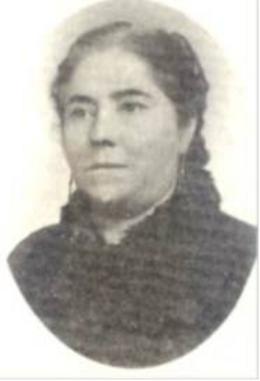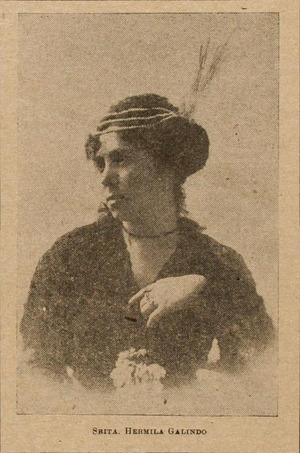Hermila Galindo facts for kids
Quick facts for kids
Hermila Galindo Acosta
|
|
|---|---|
 |
|
| Born |
Hermila Galindo Acosta
2 June 1886 Villa Lerdo, Durango, Mexico
|
| Died | 18 August 1954 (aged 68) Mexico City, Mexico
|
| Nationality | Mexican |
| Other names | Hermila Galindo Acosta de Topete |
| Occupation | journalist, activist |
Hermila Galindo Acosta (also known as Hermila Galindo de Topete) (2 June 1886 – 18 August 1954) was a Mexican writer and a strong supporter of women's rights. She was one of the first people to speak out for important changes like women being able to vote and get a divorce. Hermila was also one of the first feminists to say that the Catholic Church in Mexico was making it harder for women to gain equal rights. She made history as the first woman to run for an elected position in Mexico.
Contents
Early Life and Education
Hermila Galindo Acosta was born in Lerdo Mexico, Durango, on June 2, 1886. Her parents were Rosario Galindo and Hermila Acosta. She started school in Villa Lerdo. Later, she went to an Industrial School in Chihuahua. There, she learned useful skills like accounting, shorthand, telegraphy, and typing. She also learned both English and Spanish. When she was 13, she returned home. She then taught shorthand and typing to other children. In 1911, she moved to Mexico City.
Working for Change
Joining the Political Scene
When Hermila arrived in Mexico City, she joined a group that supported liberal ideas. Liberalism is a political belief that focuses on individual rights and freedoms. She became a public supporter of Venustiano Carranza. She worked to convince people to go against the leader at the time, Porfirio Díaz.
Carranza noticed Hermila when she gave a speech welcoming him back to the capital city. He then asked her to work with him in Veracruz. She became his private secretary. In this role, she continued to gather support for the rights of Mexican women and for liberal ideas.
Spreading Feminist Ideas
Carranza supported Hermila's efforts. He allowed her to share her ideas about women's rights in several Mexican states. These included Tabasco, Campeche, Yucatán, Veracruz, Coahuila, San Luis Potosí, and Nuevo León. Carranza also sent her to Cuba and Colombia. Her job there was to share his policies with other countries in Latin America.
In 1915, Hermila started her own magazine called La Mujer Moderna (which means "The Modern Woman"). This magazine featured essays about feminist ideas. It also helped to promote Carranza's political campaign. Many of her writings supported Carranza in some way.
The magazine also included articles that showed her disagreement with the Catholic Church. She felt the church's views were holding women back. Hermila was one of the first feminists to openly talk about the church's role in women's lives. She worked with many other journalists and feminists. Most of these women were from Spain and were fighting for similar causes. Some famous women who wrote for her magazine were María Luisa de la Torre de Otero and Clarisa P. de Torres. Even though the magazine was called The Modern Woman, she also included male journalists.
Hermila wrote Carranza's biography. She also wrote at least five other books. One of her books, Un presidenciable: el general Don Pablo Gonzalez, was about General Pablo González Garza. He was a general during the Mexican Revolution who served under President Carranza. Her strong support for Carranza was very clear. Almost all her work, even her feminist magazine, was connected to him.
Facing Opposition
Hermila's ideas about equality and women's rights were seen as very new and even shocking by some. In 1916, there was a meeting called the First Feminist Congress of Yucatán. Hermila did not attend, but a statement she wrote was read there. In it, she criticized the unfair "double standard" for men and women in Mexico. This meant that men were allowed to do things that women were not. After her statements were read, some conservative women's groups disagreed strongly. They said that women should stick to their traditional roles and did not need more education.
Carranza allowed Hermila to suggest a proposal for women's equality to a big meeting called the Constituent Congress in 1917. However, this idea was removed from the final plans. Hermila believed strongly in Carranza. She thought he could bring about a social revolution and help women get the right to vote. In the end, Carranza did not make all the changes he promised. He was seen as corrupt, which made Hermila feel disappointed.
Running for Office
On March 2, 1917, Hermila decided to take action herself. She ran as a candidate for Deputy of the 5th area of Mexico City. A historian named Gabriela Cano said that this was "the first time that, in Mexico, a woman contended as an electoral choice." Some records show that Hermila won most of the votes. However, the Electoral College, which counted the votes, rejected her results. They said they were just following the law that did not allow women to hold office. Hermila accepted their decision. But she made it clear that her goal was to show everyone that women could be elected and should be allowed to hold public office.
In 1923, Hermila attended a Feminist Congress in the State of Tabasco. She also started several revolutionary clubs in Campeche, Tabasco, Veracruz, and Yucatán. She got married later that year and stopped her direct involvement in politics.
Hermila Galindo Acosta passed away on August 18, 1954, in Mexico City.
Tributes and Recognition
On June 2, 2018, Hermila Galindo was honored with a Google Doodle in Mexico. This was on her 132nd birthday.
On November 20, 2020, Hermila Galindo was featured on the new Mexican 1000 peso banknote.
Selected Works
- La Mujer moderna (1915–1919) (in Spanish)
- Estudio de la Srita. Hermila Galindo : con motivo de los temas que han de absolverse en el Segundo Congreso Feminista de Yucatán, Noviembre 20 de 1916 (1916) (in Spanish)
- La doctrina Carranza y el acercamiento indo-latino (1919) (in Spanish)
- Un presidenciable: el general Don Pablo Gonzalez (1919) (in Spanish)
- "Mi grano de arena en esa hermosa labor." in La doctrina Carranza y el acercamiento indolatino, pp. 159–67. Mexico 1919.
See also
 In Spanish: Hermila Galindo para niños
In Spanish: Hermila Galindo para niños
Images for kids




